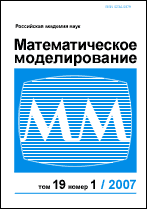|
|
Matematicheskoe modelirovanie, 1996, Volume 8, Number 9, Pages 85–94
(Mi mm1622)
|
 |
|
 |
Proceedins of the International Conference on the Optimization of the Finite Element Approximations (OFEA-95), St.-Petersburg, 25–29 June 1995
On cross-constrains method and physical contact-laws
В. A. Schrefler, G. Zavarise
Abstract:
One of the crucial problems arising during iterative solution of contact problems is related to the unstable behaviour of the contact elements. Standard formulations do not permit oscillation of the solution path from one side to the other of the constraint limits. If a recursive change of state occurs the solution may not be reached. This fact is mainly due to the discontinuity which takes place moving from the status of gap closed to the status of gap open. A new method has recently been proposed to overcome such limitations. It permits the solution to take place on both sides of the constraint limit. Change of contact status in this case is smooth, hence a more stable solution path can be obtained. The basic formulation of the cross-constraints method adopts analytical functions to represent the non-linear behaviour of the contact. Both traditional penalty and barrier methods can be obtained as limit case of the proposed technique. In this paper we extend the method by replacing the analytical functions with constitutive laws based on microscopic characterisation of contact surfaces. The formulation permits problems where high precision and physical insight are required, to be dealt with. Many high-tech problems can be analysed by using the proposed method; the present work is a preliminary step for the thermomechanical analysis of cable in conduit superconductors.
Citation:
В. A. Schrefler, G. Zavarise, “On cross-constrains method and physical contact-laws”, Matem. Mod., 8:9 (1996), 85–94
Linking options:
https://www.mathnet.ru/eng/mm1622 https://www.mathnet.ru/eng/mm/v8/i9/p85
|

| Statistics & downloads: |
| Abstract page: | 274 | | Full-text PDF : | 84 | | First page: | 1 |
|




 Contact us:
Contact us: Terms of Use
Terms of Use
 Registration to the website
Registration to the website Logotypes
Logotypes








 Citation in format
Citation in format 